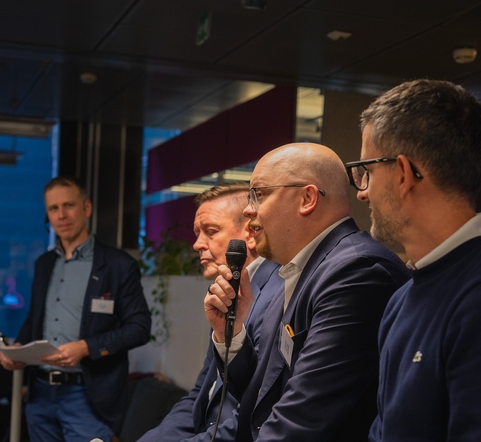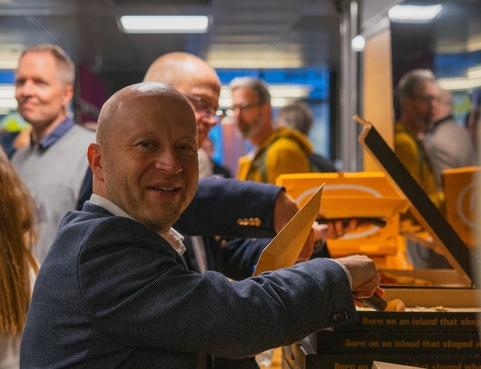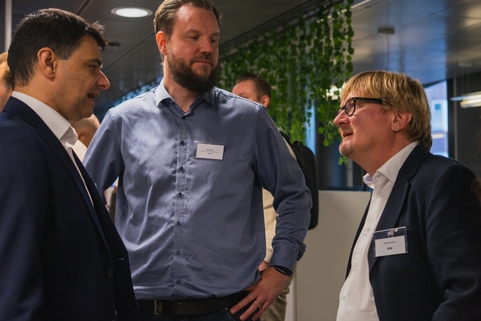
Date
16 October 2025
Category
PaymentsThe future of payments in Europe: Interoperability, expansion, and the race for one brand
From Nordic expansion to cross-border interoperability and shared brands, here’s how the industry plans to build a truly European payment ecosystem – and why it matters.

This article was written by:
Sami Nurmi, Senior Advisor & Team Lead, Payments
European payments are growing up
Payments in Europe are moving from local innovation to continental collaboration. What began as a handful of national wallet apps – like Vipps, MobilePay, Siirto, Swish in the Nordics – is now becoming a conversation about interoperability, user experience across borders, and European independence from global payment giants.
At a recent industry discussion hosted by Qvik, leaders from major Nordic and European payment schemes shared their views on how payments will evolve – and what it will take for Europeans to finally pay anywhere in Europe with one simple tap.
Here’s what we learned!
Expansion starts at home, then moves outward
For Nordic players, growth begins with consolidation at home.
For MobilePay, for example, Finland currently has around 2.8 million users, with a goal to reach 4.5 million by 2027 – similar to user bases in Norway and Denmark. Sweden, at roughly 400,000 MobilePay users, is still at an “opening position” for further expansion. Swish dominates the Swedish market with close to 9 million users.
Together, millions of users in the Nordics are already completing transactions with merchants and each other daily.
Once the Nordics are fully connected, the natural path leads toward the Baltics, Germany, and Iceland. Expansion will be steady, not reckless. As one of our panelists put it, “We want to be a truly Nordic company first, before moving south.”
The strategy is pragmatic: consolidate what works, prove interoperability at scale, and only then expand to new markets.
Three types of European markets – and why some are harder than others
Europe’s diversity is both its strength and its biggest hurdle. From the payments perspective, countries fall into three rough categories:
- The open markets – countries without a strong local payment scheme. They’re “easier” to enter on paper, but often lag in adoption for structural reasons.
- The struggling innovators – countries that built local solutions that never scaled. Many are now considering migration to shared European initiatives like EuroPA to gain reach and cost efficiency.
- The fortress markets – countries where dominant local players (like Swish in Sweden or Blik in Poland) make new entry almost impossible.
For this last group, interoperability is key. Rather than replacing local solutions, European schemes aim to connect – allowing payments between systems that were never designed to communicate.
True interoperability – why it is harder to build than it sounds
Everyone agrees interoperability is the future. The challenge is getting there.
Europe’s payment systems evolved in silos:
- Some are run by central banks, others by private players.
- Some are full payment systems; others just front-end experiences.
- Some are card-based, others are account-to-account.
Now Europe is trying to weave them together retroactively.
“These systems were created in total isolation. Amazing solutions on their own – but when you cross borders, you realize how different they really are.”
Nordic innovators like Siirto demonstrate how existing national solutions can evolve into cross-border enablers with their collaborative approach and open APIs, setting the stage for real Europe-wide interoperability.
Technical infrastructure, regulation, and standardization (like SEPA Instant and the ECB’s TARGET services), however, all need to mature before seamless cross-border payments can truly work. Even optimistic estimates put full interoperability around 2030.
Why Europe needs a single recognizable brand
The next frontier isn’t just technical, it’s psychological.
When you travel, you don’t think about who issued your card. You look for the Visa or Mastercard logo. That’s the power of one strong brand – a universal trust signal for users and merchants. Mobile payments don’t yet have that.
“Visa and Mastercard did it brilliantly. You don’t look for your bank’s logo – you look for theirs.”
Right now, European wallets are fragmented. You pay with Vipps in Norway, MobilePay in Denmark, Bizum in Spain, Iris in Greece. Each strong locally – but confusing when you travel.
Without a shared symbol of trust, Europe risks building dozens of excellent silos. A single interoperable European brand could bridge that gap.
Regulation and standardization are the quiet enablers
If history is any guide, regulation will make things happen faster than innovation alone.
Take SEPA Instant: in Germany, adoption leapt from 10% to over 90% only after it became mandatory.
The same principle applies to open POS terminals and standardized merchant interfaces. Europe already has the standards, it just needs the political will to enforce them.
Mandates are rarely glamorous, but they’re often the missing piece between vision and reality.
Consolidation is coming – because US tech giants are the competition
Europe currently hosts over 40 active consumer-facing mobile wallets and apps. In five years, that number will shrink.
Consolidation isn’t failure, but maturity. As interoperability grows, regional products will merge or align, forming a few large networks instead of dozens of small ones.
The fact is that the real competitors aren’t local anymore. They’re Apple Pay, Google Pay, Visa, and Mastercard. Competing with global tech giants requires scale, speed, and simplicity – and those are things Europe can only achieve together.
European independence starts with account-to-account, but watch who’s building it
A key question lingers: If account-to-account payments are supposed to “free Europe” from card networks, what happens when Visa and Mastercard start offering A2A solutions themselves?
It’s a fair concern. Many PSD2 and open banking providers are already owned by those same global giants. If pricing pressure drives adoption of their infrastructure, Europe might find itself more dependent than before – unless A2A infrastructure stays European-built and European-governed.
Some industry voices argue it’s time for the EU to mandate this explicitly, but whether that happens or not remains uncertain.
Milestones for the next few years
Despite the challenges, momentum is building. Cooperation between players like Vipps MobilePay, EuroPA, and EPI is real and growing.
We can expect to see:
- Full person-to-person interoperability between Nordic and Southern European corridors by 2026–2027.
- Unified POS and e-commerce acceptance closer to 2030.
- A clearer European payment identity built through shared branding and policy
In other words: the road to a unified European payment experience is long, but it has finally begun.
The takeaways
Europe’s payments industry is shifting from national pride to a shared purpose. Consumers don’t care who built the system, they just want to pay anywhere, instantly, and securely.
For merchants, this evolution isn’t just technical – it’s an opportunity to simplify the payment experience and reduce costs by exploring new account-to-account and interoperable solutions.
As these services mature, they promise faster settlement, fewer intermediaries, and better margins, all while keeping the user experience seamless.
For other stakeholders, from banks to policymakers and fintechs, the message is similar: collaboration and openness are now the main currencies of progress.
The direction is clear – from many separate systems to one experience – and every player in the ecosystem has a role in making it happen.
Now is the time to explore, test, and partner across borders to help shape the next phase of Europe’s payment landscape.















